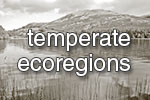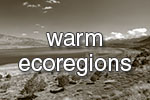Lakes in cold ecoregions - affected species
Climate change will have impacts on freshwaters through changes in hydrology e.g. through more frequent floods, but mainly through increased temperatures. Water temperature is a main determinant of water quality (such as oxygen concentration) and an increase will lead to chain of events that may affect community composition. In cold ecoregions, for example, extension of the ice-free period and increased water temperature will lead to enhance primary production and eutrophication, desynchronise life cycles and cause physiological problems for cold-adapted species. Cold-water stenothermic species which inhabit alpine stream environments for example are especially vulnerable to warming and snow loss (Brown et al. 2007). In, warmer regions, such as the Mediterranean, normal interannual variations are expected to be more extreme and this together with elevated temperatures and salinities would result in more frequent harsh conditions to the local biota. In central European regions temperature raise is predicted to lead to the extinction of sensitive species, such as several aquatic insects (Stoneflies) and fishes such as the European bullhead (Cottus gobio) (Logez et al., 2012). The spreading of invasive or alien species is also expected to occur in a more rapid way as habitats will become more suitable for invasion and establishment.
This section presents examples of species that according to current scientific literature may be positivly or negativaly affected by climate change (“winners” or “losers”). For each ecosystem type (rivers, lakes and wetlands) and ecoregion (cold, temperate and warm) and different organism groups (phytoplankton/macrophytes, macroinvertebrates and fish) are presented.









